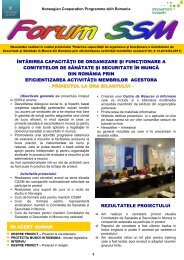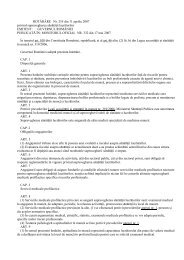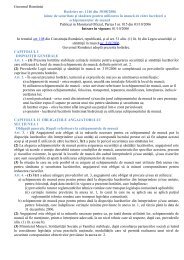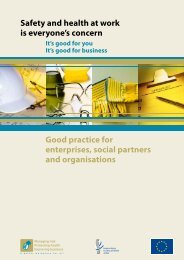Preventing work-related musculoskeletal disorders - European ...
Preventing work-related musculoskeletal disorders - European ...
Preventing work-related musculoskeletal disorders - European ...
Create successful ePaper yourself
Turn your PDF publications into a flip-book with our unique Google optimized e-Paper software.
<strong>Preventing</strong> <strong>work</strong>-<strong>related</strong> <strong>musculoskeletal</strong> <strong>disorders</strong><br />
the complaints and reports of MSDs, which are no less frequent than<br />
before. The efficiency of the production line has been lost.<br />
Gradually, everyone agrees that <strong>work</strong>ing standing up is not an<br />
improvement. An attempt is then made to reach a compromise on<br />
the number of permitted seating positions in the line. But other<br />
events can also frustrate the aims of the reorganisation. The<br />
presence of a few articles put down in the gaps between<br />
<strong>work</strong>stations becomes more and more common. Talks prove<br />
difficult, because this is a key principle in the quest for flexibility.<br />
But what kind of flexibility is this? Work analysis shows that these<br />
few articles play a part in helping to control the rhythm and alleviate<br />
the tedium of the <strong>work</strong>. A few units assembled in advance enable an<br />
operator to vary his speed of <strong>work</strong>ing and enjoy a few moments’<br />
rest. They form a buffer stock that creates some space for attending<br />
to activities within the group, such as, for example, being available<br />
to help out a colleague, exchanging information, etc.<br />
MSDs arise where this kind<br />
of organisational<br />
MSDs arise where<br />
dependence exists.<br />
Operators are less and less organisational dependence<br />
able to use their own<br />
exists.<br />
resources (their skills, knowhow,<br />
creativity, etc.) in<br />
deciding their movements.<br />
Identifying the factors that make individuals more dependent on<br />
organisational constraints is one approach to prevention. More<br />
accurately, the organisational risk factor lies in the application<br />
principle adopted (for example, the elimination of buffer stocks)<br />
rather than in the production concept (lean manufacturing) itself. In<br />
this way we can identify where action is needed (the possibility of<br />
sitting down to <strong>work</strong>, establishing mini-stocks, etc.) and whom it<br />
should involve (designers, instructors, operators, etc.).<br />
MSD PREVENTION AND ORGANISATIONAL EFFICIENCY<br />
are no guarantee of the absence of MSDs and may indeed be a<br />
signal for their appearance. Why?<br />
Because they have been unable to preserve the room for manoeuvre<br />
that the operators enjoyed even on the production line. We can<br />
illustrate this argument by the example of an assembly line.<br />
PRICE OF PROGRESS<br />
Engineers are required to meet more stringent market requirements,<br />
to enable new product lines to be launched and productivity gains<br />
achieved. One of the solutions to these problems offered by<br />
organisational technology is the U-line, which allows the number of<br />
<strong>work</strong>ers to be adjusted to the level of demand. If the number of<br />
positions open is unchanged, on the other hand, the size of the<br />
<strong>work</strong>force is geared to the volume of orders. Each operator may<br />
therefore be required to move between two or more jobs. This tactic<br />
requires operators to be more versatile, and to <strong>work</strong> standing up. It<br />
also enables the areas in which articles are reached to be brought<br />
closer, and allows a saving of space by bringing the <strong>work</strong>stations<br />
closer together. The holding of buffer stocks between two<br />
<strong>work</strong>stations thus becomes impossible.<br />
From the management’s standpoint, this makes for more efficient<br />
<strong>work</strong>ing and provides greater flexibility in the achievement of<br />
objectives because the presence of <strong>work</strong> in progress between<br />
<strong>work</strong>stations is often a fault that incurs penalties. After such situations<br />
have existed for a while, as everyone knows, seats tend to reappear.<br />
Their presence violates a management ban, resulting in a conflict<br />
situation, generally a suppressed one: deterioration of labour relations,<br />
lack of job satisfaction, turnover, absenteeism, etc., all in addition to<br />
There is also a fear on the part of management that attempts to<br />
prevent MSDs will result in a slowing of performance, as if MSDs<br />
were, in some way and despite everything, the price to be paid for<br />
“holding one’s ground” in an increasingly commercial market. The<br />
very reverse is true.<br />
MSDs reveal sources of<br />
non-productivity which the<br />
MSDs reveal sources<br />
company has been unable<br />
to identify or associate of non-productivity which<br />
with the conditions under<br />
which the <strong>work</strong> is done. A the company has been<br />
particular focus of the<br />
unable to identify.<br />
preventive approach is<br />
identification of these<br />
links. For example, the person in charge of a meat-boning unit<br />
denied that there was any connection between the speed of the line<br />
and the occurrence of MSDs. Work analysis showed very high<br />
density of movement, forcing operators to reduce the frequency<br />
with which they sharpened their knives, in order to save time. But,<br />
as the knives cut less efficiently, so the cutting effort required was<br />
greater and accuracy worsened. The person in charge of the line<br />
suddenly understood the link between <strong>work</strong>ing movement<br />
conditions and efficiency, and it was only at that point that he<br />
recalled the high wastage rate. This result of non-productivity had<br />
been kept confidential up to that time.<br />
These examples clearly show the risk involved in dissociating<br />
prevention from the achievement of production objectives.<br />
Preventive solutions, then, involve the promotion of organisational<br />
alternatives which maximise the economic value obtained from the<br />
<strong>work</strong>ers’ skills, know-how and movement strategies.<br />
<strong>European</strong> Agency for Safety and Health at Work<br />
25








